Information and help
Avalanche bulletins
An avalanche bulletins is a regional avalanche forecast where the danger level is classified in 5 categories according to European standards (European Avalanche Warning Services, EAWS). The forecast is made for large areas and includes both natural and human triggered avalanches. Two things are important regarding the bulletins:
- It is not necessarily representative for urban areas.
- It does not replace the assessment of individuals of conditions when travelling and sensible terrain selection
The Icelandic Met Office (IMO) also monitors avalanche danger in settlements, where other standardized terms are used. Click here for further information.
Who are the users of the bulletin?
The bulletin is aimed towards backcountry travelers, even though it can be useful for others as well. It gives the public access to snow- and avalanche conditions at a regional scale in specific areas. The bulletin is general due to limited information and it applies to a large area of land. Thus, it does not replace local assessment at any given time. However, it is one of the tools that individuals can use to estimate avalanche danger at a local scale.
Avalanches are one of the main sources of risk for backcountry travelers in mountains during winter time. In most avalanche incidents in the backcountry it is the victim himself or someone in his group who triggered the avalanche. The bulletin displays existing information on snow layering and recent avalanches in the area. The nature of the avalanche danger is described as well as the areas people should especially avoid. The layering and stability of snow is often very variable both spatially and temporally. Local avalanche danger may, thus, be in more areas than the bulletin describes, and avalanches may have released in more areas than reported.
Nobody should travel in steep slopes during winter time without knowing how to assess avalanche danger and make appropriate terrain selection. The safety can be increased considerable by avoiding all terrain steeper than 30°. Should an accident happen, it is important to have the right equipment for companion rescue: avalanche beacon, shovel, avalanche probe, and the knowledge to use the equipment.
Areas
The bulletin is issued for three areas: Northern Westfjords, part of Tröllaskagi and East fjords. The reason why the bulletin is made for these three areas is that IMO’s snow observers work in the area as a part of the monitoring system for settlements. They collect weather and snow data that are essential for avalanche forecasting. In those areas backcountry travelling is popular during winter time. Hopefully bulletins for more areas will be added in the future, e.g. for the area around Reykjavík.
When are bulletins issued?
A bulletin is generally issued on Mondays, Wednesdays and Fridays at 16 o’clock. It is updated more often if needed. The forecast is made for three days, and a frame identifies the current day.
More about the bulletin
The bulletin is made according to European standards, using a standardized danger rating system of EAWS (European Avalanche Warning Services). In May 2018 the visualization of the bulletin was changed from what it was before according to EAWS standards. Five types of avalanche problems are identified.
A short version of the bulletin is displayd on the front page. By clicking the area of interest a more detailed bulletin appears.
Avalanche danger scale
| Danger level | Icon | Snowpack stability | Avalanche triggering probability | |
|---|---|---|---|---|
| 5 - Very high | 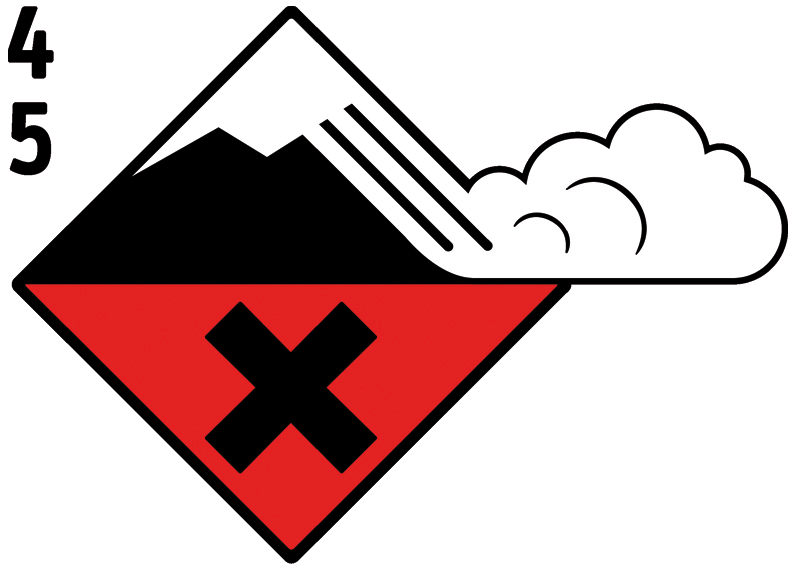 |
The snowpack is poorly bonded and largely unstable in general. | Numerous large-sized and often very large-sized natural avalanches can be expected, even in moderately steep terrain* | |
| 4 - High |  |
The snowpack is poorly bonded on most steep slopes*. | Triggering is likely even from low additional loads**, on many steep slopes*. In some cases, numerous medium-sized and often large-sized natural avalanches can be expected. |
|
| 3 - Considerable |  |
The snowpack is moderately to poorly bonded on many steep slopes*. | Triggering is possible, even from low additional loads** particularly on the indicated steep slopes*. In some cases medium-sized, in isolated cases large-sized natural avalanches are possible. | |
| 2 - Moderate | 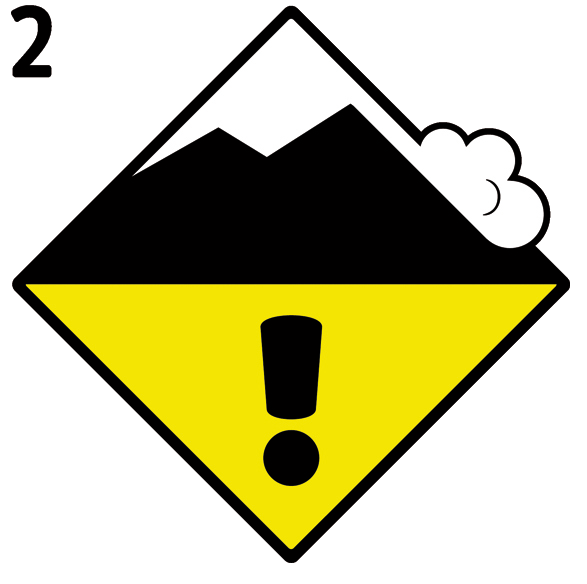 |
The snowpack is only moderately well bonded on some steep slopes* otherwise well bonded in general. | Triggering is possible primarily from high additional loads**, particularly on the indicated steep slopes*. Large-sized natural avalanches are unlikely. | |
| 1 - Low | 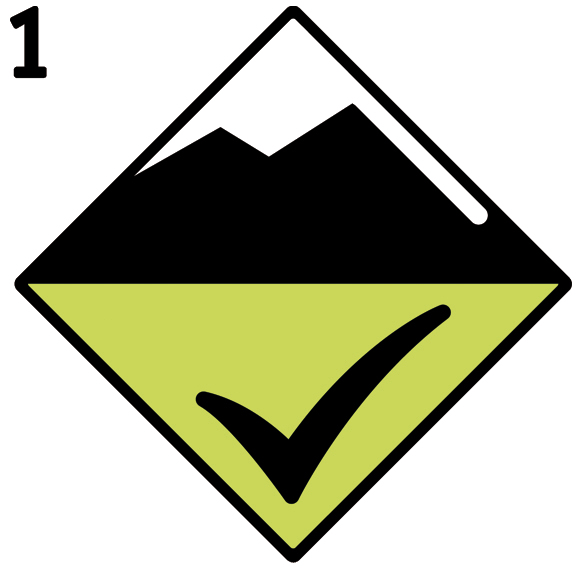 |
The snowpack is well bonded and stable in general. | Triggering is generally possible only from high additional loads** in isolated areas of very steep*, extreme terrain. Only sluffs and small-sized natural avalanches are possible. | |
| No forcast | 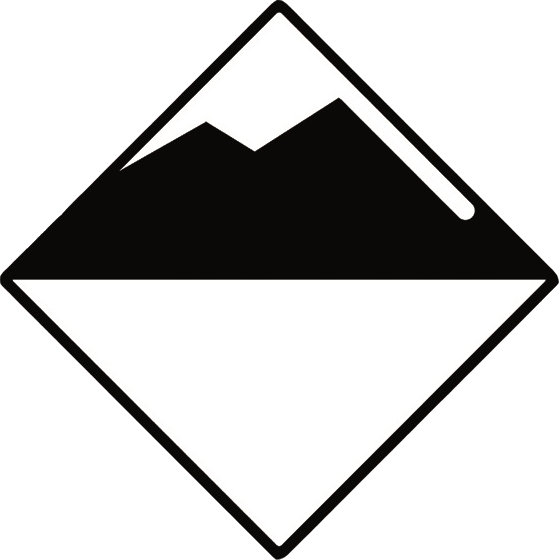 |
The avalanche-prone locations are described in greater detail in the avalanche bulletin (altitude, slope aspect, type of terrain)
- moderately steep terrain: slopes shallower than 30 degrees
- steep slope: slopes steeper than 30 degrees
- very steep, extreme terrain: adverse slope angle (more than 40 degrees), terrain profile, proximity to ridge, smoothness of underlying ground surface
** Additional loads:
- low: individual skier / snowboarder, riding softly, not falling; snowshoer; group with good spacing (minimum 10 m) keeping distances
- high: two or more skiers / snowboarders etc. without good spacing (or without intervals); snowmachine; explosives; single hiker/climber
Avalanche sizes
The IMO database uses a classification for avalanche sizes that is originated in Canada. The classification is based on the destructive potential of the avalanche, and it has been slightly modified for Icelandic conditions. The table also gives a typical mass in tons.
| Size | Destructive potential | Mass |
|---|---|---|
| 1 | Minimal danger of burying (danger of falling). | 10 tonn |
| 2 | Could bury, injure or kill a person. | 100 tonn |
| 3 | Could bury and destroy a car, damage a truck; destroy a small building or break a few trees. | 1000 tonn |
| 4 | Could bury and destroy a railway car, large truck, several buildings or a piece of forest. | 10.000 tonn |
| 5 | Could gouge the landscape; disastrous damage potential. | 100.000 tonn |
It is not always easy or obvious how to classify the size of an avalanche, however, the destructive potential is the predominant factor. In many cases thin avalanches with little power are classified as size 1 or 2 even though the mass is greater than the last column indicates.
Avalanche problems
The five typical avalanche problems as defined by the European Avalanche Warning Services EAWS aim to describe typical situations as they occur in avalanche terrain and to support avalanche professionals and recreationists in their evaluation of the avalanche hazard.
When the avalanche danger is rated 2 (yellow) or higher, one or more avalanche problems are always defined for the area of concern. The bulletin includes an estimation of where in the terrain the avalanche problem is most likely to be found (elevation and aspect), the probability of avalanche release and likely maximum size of avalanches.
The purpose of defining avalanche problems is to improve and simplify the display of regional avalanche forecasts and describe avalanche conditions in a simple way. People should always bear in mind that the forecast is a simplification of reality and dangers can be hidden in more places than the bulletin describes.
https://lawine.tirol.gv.at/data/eaws/typical_problems/EAWS_avalanche_problems_EN.pdf
Different types of avalanche problems:
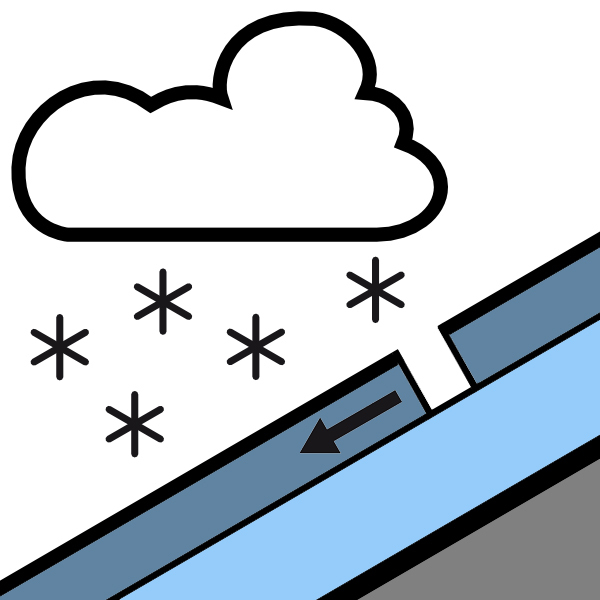 New snow New snow |
|||
|---|---|---|---|
| What? | Characteristics | The avalanche problem is related to current or most recent snowfall. The amount of additional loading by new snow onto the existing snowpack is the crucial factor of the new snow problem. How critical the loading is depends on various factors such as temperature or characteristics of the old snow surface. | |
| Expected avalanche types |
|
||
| Where? | Spatial distribution | Generally widely present and often in all aspects. | |
| Position of weak layer sin the snowpack | Usually at the transition to the old snow surface, but sometimes in the new snow layer sand sometimes also deeper in the old snowpack. | ||
| Why? | Release characteristics | Dry-snow slab avalanches:
|
Dry loose snow avalanches:
|
| When? | Duration | Typically during snowfall and up to a few days after. | |
| How to manage? | Identification of the problem in the field | The new snow problem is fairly easy to recognize. Watch out for new snow amounts and recent avalanche activity. Be aware of slight weather changes (e.g., changes in air humidity) affecting new snow conditions. | |
| Travel advice | Dry-snow slab avalanches:
|
Dry loose snow avalanches:
|
|
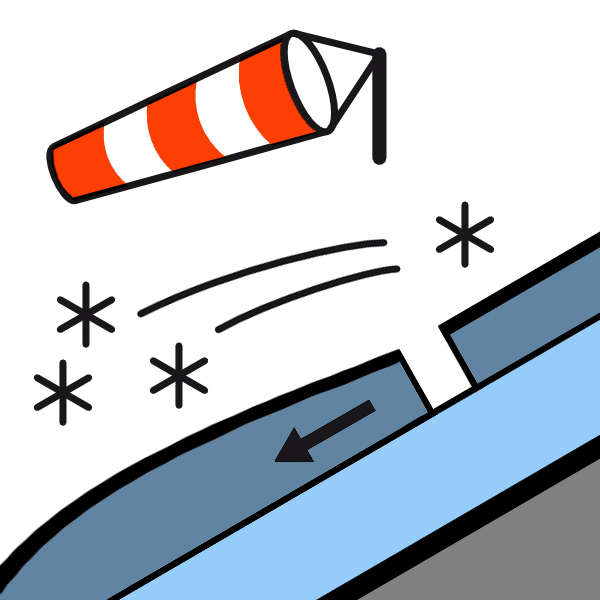 Wind-drifted snow Wind-drifted snow |
|||
|---|---|---|---|
| What? | Characteristics | The avalanche problem is related to wind-drifted snow. Snow can be transported by wind with or without a concurrent snowfall. | |
| Expected avalanche types |
|
||
| Where? | Spatial distribution | Highly variable but typically on leeward sides in gullies, bowls, near distinct changes in slope angle, behind ridgelines or other wind-sheltered locations. More common above treeline. | |
| Position of weak layer sin the snowpack | Usually at the transition to the old snow surface or within the windslab layer due to variation in wind speed and variation during storm cycle, but occasionally also deeper in the old snow cover. | ||
| Why? | Release characteristics | Wind-drifted snow is an additional load on a weak layer and builds a slab shich is particularly prone to support crack propagation. | |
| When? | Duration | Wind-drifted snow can evolve very quickly. The problem lasts typically during the snowdrift event, up to a few days at most, depending on snowpack evolution. | |
| How to manage? | Identification of the problem in the field | If not hidden by new snow the wind-drifted snow problem can be recognized with training and good visibility. Consider wind signs and locate deposits. Typical clues: snowdrift deposits, recent avalanche activity and sometimes shooting cracks or whumps. However, it is often hard to determine the age of wind signs and wind signs do not necessarily imply an avalanche problem (e.g., in absence of a weak layer) | |
| Travel advice | Avoid snowdrift deposits in steep terrain, in particular in areas where the snow cover changes from thin to thick or from hard to soft. | ||
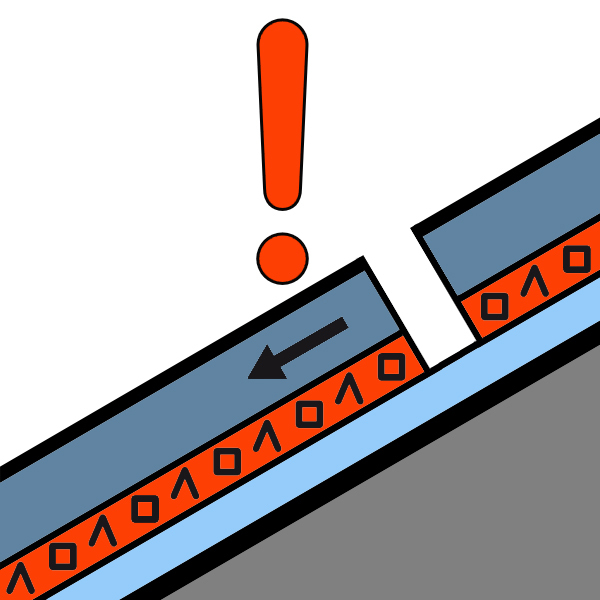 Persistent weak layers Persistent weak layers |
|||
|---|---|---|---|
| What? | Characteristics | The avalanche problem is related to the presence of persistent weak layers in the old snowpack. These weak layers typically include buried surface hoar, depth hoar or faceted crystals.. | |
| Expected avalanche types |
|
||
| Where? | Spatial distribution | The avalanche problem can be widespread or quite isolated. It can exist in all aspects, but is more frequent on shady, wind sheltered slopes. | |
| Position of weak layer sin the snowpack | Anywhere in the old snowpack, often deep in the snowpack. However, when deeply buried triggering becomes increasingly hard. | ||
| Why? | Release characteristics | Release of avalanche when loading exceeds the strength of the weak layer. | |
| When? | Duration | Weak layers can persist for weeks to months; possibly most of the winter season. In Iceland, long periods with persistent weak layers are uncommon. | |
| How to manage? | Identification of the problem in the field | Persistent weak layers are very challenging to recognize. Signs of instability such as whumps are typical but not necessarily present. Stability tests can be helpful to detect the persistent weak layers. Information on snowpack history is critical and reference to the published avalanche report is important. Crack propagation over long distances is common and remote triggering is possible. | |
| Travel advice | Travel conservatively and avoid large steep slopes. Consider the history of weather and snow cover processes in the area. Be extra cautious in areas with a thin snowpack and at the transition from thin to deep snowpack. This problem is a major cause of recreational avalanche fatalities in many countries. | ||
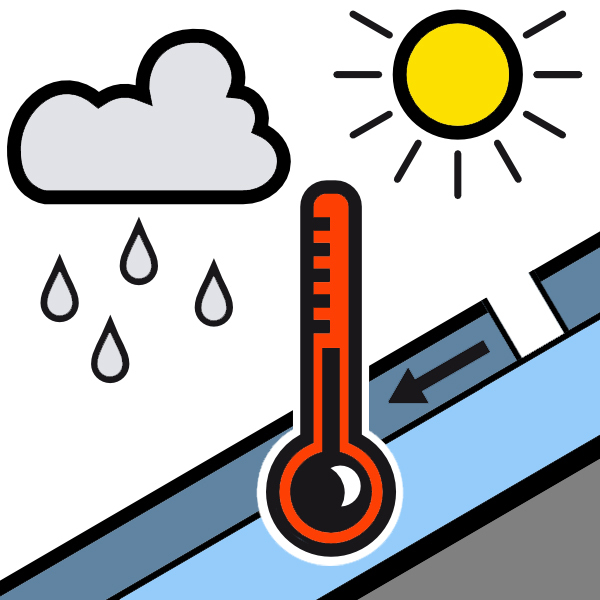 Wet snow Wet snow |
|||
|---|---|---|---|
| What? | Characteristics | The avalanche problem is related to weakening of the snowpack due to the presence of liquid water. Water infiltrates the snowpack due to melt or rain. | |
| Expected avalanche types |
|
||
| Where? | Spatial distribution | When sun is the main cause, distribution of the problem is mostly depending on aspect and elevation. All aspects are affected in the event of rain on snow. | |
| Position of weak layer sin the snowpack | Anywhere in the snowpack. | ||
| Why? | Release characteristics | Wet-snow slab avalanches:
|
Wet loose snow avalanches:
|
| When? | Duration |
|
|
| How to manage? | Identification of the problem in the field | The wet snow problem is usually easy to recognize. Onset of rain, snowballing, pin wheeling and small wet slabs or loose wet avalanches are often precursors of natural wet-snow slab avalanche activity. Deep foot-penetration is another sign of increased wetting. | |
| Travel advice | In the presence of a sun crust the conditions after cold nights with clear skies are usually favorable in the morning due to freezing. After warm nights with overcast skies the problem often exists already in the morning. Normally rain on fresh snow creates this problem almost immediately. Good timing and trip planning are important. Consider avalanche runout zones. | ||
 Gliding snow Gliding snow |
|||
|---|---|---|---|
| What? | Characteristics | The entire snowpack is gliding on the ground, typically on smooth ground such as grassy slopes or smooth rock zones. High activity of glide-snow avalanches are typically related to a thick snowpack with no or only few layers. Glide snow avalanches can occur both with a cold dry snowpack and with a warm wet snowpack. The release of a glide-snow avalanche is difficult to predict, although glide cracks open usually before a release. Rare in Iceland. | |
| Expected avalanche types |
|
||
| Where? | Spatial distribution | Predominant on smooth ground and on every aspect, but more often on south-facing slopes. | |
| Position of weak layer sin the snowpack | Interface between the ground and overlaying snowpack. | ||
| Why? | Release characteristics | Glide-snow avalanches are caused by a loss of friction at the snow-ground interface. | |
| When? | Duration | Days to months; possibly entire winter-season. The release can occur at any time during the day. In the spring, gliding avalanches occur mostly in the later part of the day. | |
| How to manage? | Identification of the problem in the field | With the presence of glide cracks the problem can often be localized, however, the presence of glide cracks does not indicate imminent avalanche release, as this is nearly impossible to predict. Avalanche release without pre-existing glide cracks is also common. | |
| Travel advice | Avoid areas close to glide cracks. | ||
Elevation
In the avalanche bulletin, the elevation is sometimes classified into two elevation bands. An avalanche problem can be connected to elevation above or below a certain level. The border of the elevation band is defined in each bulletin. An avalanche problem can, thus be mostly existent above 800 m a.s.l. or below 500 m a.s.l. In some cases an avalanche problem is believed to be existent at all elevation levels from sea level to the highest mountain peaks. As before, it is pointed out where the avalanche problem could be most dominant, not excluding that it exists in other areas.
Aspect
The aspect of a slopes is the direction the slope faces. An avalanche problem is sometimes mostly connected to certain aspects. However, it should be expected to be found in other areas, even though it might be most common in a certain aspect.
Probability
For each avalanche problem the probability of release is defined: Unlikely, Possible, Likely, Very likely, Certain Be aware that this is a rough estimation including both human triggered and natural avalanches. Probability of a human triggered avalanche depends on the trigger.
Civil protection phases describing possible avalanche danger in settlements
Standardized terms exist to describe preparedness of the civil protection system in Iceland due to all types of natural hazards
Uncertainty phase
Óvissustig vegna snjóflóðahættu felur í sér aukinn viðbúnað snjóflóðavaktar Veðurstofunnar og snjóathugunarmanna ásamt samráði við lögreglu og almannavarnir í héraði vegna snjóflóðahættu sem upp kann að koma í byggð.
Uncertainty phase due to avalanche danger includes increased preparedness of the avalanche monitoring group at the Icelandic Met Office, snow observers as well as consultation with local police and civil protection due to avalanche danger that might come up in settled areas.
The uncertainty phase does not indicate that the danger is existent, but that it might come up. Uncertainty phase is declared to make the system ready for e.g. order evacuation of houses if needed. It is declared for predefined parts of the country, not individual towns or villages, however, the danger is often localized within that area.
Danger phase
Danger phase is the next step up in preparedness. In urban areas a danger phase due to avalanche danger means that houses are being evacuated according to evacuation plans.
Emergency phase
Emergency phase is declared when accident has happened and damages have occurred. Immediate action is taken to safe human lives, attempt made to avoid further accidents and damages.



